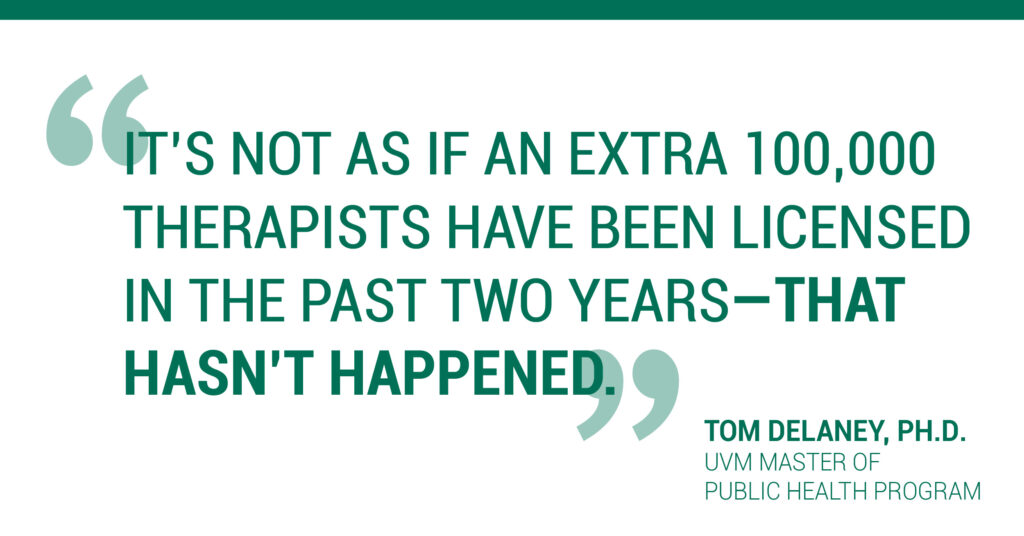In case you haven’t noticed, the past few years have been rough – emotionally, psychologically, physically, and logistically. As we navigate the collective trauma wrought by the pandemic, many of us are turning to therapy to process grief and adjust to new ways of living.

On the one hand, it’s great news that so many people – about a third of all adults – are flocking to therapy for support. In an age where therapy still carries stigma for some, it’s encouraging to see just how many folks have reached out for professional help. On the other hand, the sheer volume of people pursuing therapy has created something akin to the mad dash for toilet paper in the pandemic’s earliest days. There are only so many therapists available to meet the demand, and you may find yourself shopping around more than you care to in order to find an open appointment.
Tom Delaney, Ph.D., associate professor at the University of Vermont’s Larner College of Medicine, recently weighed in on the strained supply/demand dynamic going on in the world of therapy for a Popular Science article on the current challenges of finding a therapist. Delaney, who researches mental health program effectiveness, notes the numbers problem that many prospective patients are encountering in their therapy search.

As more people are seeking therapy – one in six Americans started therapy for the first time in 2020 – many are relegated to appointment wait lists that can be many months long. It’s hardly ideal. In some cases, the wait time may deter the prospective patient from following up or widening their search, causing mental health concerns to go unaddressed.
Finding a Good Fit for Your Needs is Still Important – Even in an Era of Scarcity
In a recent follow up conversation to the Popular Science article, Delaney added further color to the current state of mental health in the U.S. “I track data from poison control centers, and we are seeing record breaking visits by young people to EDs for ingestion, and record-breaking numbers of calls into call centers, as well,” he explains. “Suicidal ideation trends are way up, too, with self-harm behavior now skewing younger.”
Delaney explains how people experiencing a mental health crisis may be forced to seek help in an emergency department for lack of other options. “What we’re seeing more of, especially in rural areas, is the ED turning into the entry way for the mental healthcare system. And that’s not always the best place, because the ED can be traumatizing. If it’s a good ED, people will be kept safe from harming themselves, but they’re not going to receive psychiatric treatment; they’re just going to be managed in terms of safety.”

Given the current scarcity of providers, a patient may feel relieved to find an open appointment and feel forced to commit to the first therapist they meet. If you’ve been searching for an appointment for months, finding the perfect fit for your needs may feel like a luxury rather than a necessity. Yet Delaney emphasizes that fit is in fact an important part of effective therapy, and that every patient should, at minimum, assess whether they feel respected and heard. “If you don’t feel respected based on your gender, race, religion, or anything else, then it’s a major red flag. You also want to feel like you’re making progress. If you don’t feel like you’re seeing any light at the end of the tunnel, that is also a concern,” he says.
In terms of fit, Delaney also advises to keep an open mind when considering a therapist’s credentials. “Ask about licensure,” he says, “but be aware that if a person is not yet licensed and is working as a trainee, that can actually be fine, as long as they are being supervised.” He also cautions against substituting life coaching for evidence-based therapy modalities. Life coaches, he explains, can be a valuable supplement to therapy, but should not be regarded as an appropriate substitute for mental health care.
If you do connect with a therapist, a good way to assess fit early on is to treat your initial conversation like a job interview. Ask questions of the therapist, including how they have helped other people like you and if they are willing to explore multiple treatment paths, or prefer to treat with a single modality. Delaney also urges patients to remember that they are totally within their right to ask questions and should not be intimidated by a therapist’s credentials or status as a health professional. Any therapist who suggests your inquiries are a burden, he says, is probably not a good fit.
Additional Stories You May Find Interesting:
- Self-Care and Community Care: A COVID-19 Safety Mindset as Variants Emerge
- Business as Usual: Expert Advice to Return to the Office Safely
- Research in Action: Comprehensive Suicide Prevention in Vermont




